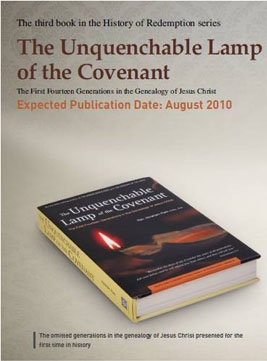
TThe mystery of the generations omitted from the genealogy of Jesus Christ
The reason that the genealogy of Jesus Christ recorded in the first chapter of the New Testament is because all the characters that appear in the genealogy form a passage to God's administration for redemption, through which the Messiah the Savior of all mankind came to the earth. The genealogy of Jesus Christ does not only reveal the orthodoxy of the physical lineage, but also shows the footsteps of faith that continued down through the generations of faith until Jesus Christ came to the earth through incarnation. One thing we must notice is the fact that this genealogy in Matthew chapter 1, unlike other
ordinary genealogies that are recorded in the order of lineage, is not a record of continuous generations without omissions. Rather, there are many generations omitted in several places in this genealogy.
1. The generations omitted from the 430-year period of slavery in Egypt
Hezron, the grandson of Judah is included in the list of the 70 people in Jacob's family at the time of migration to Egypt (Gen 46:12). Hezron, thus, is a character that lived during the first stage of the 430-year period of slavery in Egypt. Seeing that Amminadab's son Nahshon appears as a leader of the sons of Judah during the journey in the wilderness after the Exodus (Num 2:3, 10:14), he must have been of the last generation of the slavery in Egypt. Since Rahab the harlot lived during the first stage of the Canaanite conquest after the entry into Canaan in 1,406 BC (Josh 2:1), Salmon, who married Rahab, was a second generation born in the wilderness and his father Nahshon was the last generation who lived under slavery in Egypt.
This summarizes that the genealogy of Jesus Christ records only four generations-Hezron, Ram, Amminadab, and Nahshon (Matt 1:3-4) - for the 430-year period of slavery in Egypt. Considering the fact that the actual number of generations for this period of time - from Ephraim to Joshua - is 10 generations (1 Chr 7:20-27), it is deduceable that the genealogy of Jesus Christ has many generations ommitted from the 430-year period of slavery in Egypt.

2. The generations omitted from the period of the settlement in Canaan and King David
The time Israel entered into Canaan after the Exodus was 1,406 BC and the time David appeared in history was about 1,010 BC. Nevertheless, the genealogy of Jesus Christ only records four generations - Salmon, Boaz, Obed, and Jesse (Matt 1:5-6) - for the long period of about 396 years.
As mentioned above, Salmon and Rahab were people who lived during the first stage
in the period of the Canaanite conquest whereas Boaz and Ruth were people who lived during the last stage in the period of the Judges (Ruth 1:1, 4:21-22). In other words, there is a gap of more than 300 years between Salmon and Boaz. Jephthah, who was one of the last judges, argues with the king of Ammon that it is wrongful to claim
the land of Israel when it had been the land of the Israelites for 300 years already (Jdg 11:26). We are confronted with a shocking fact that people who lived during the dark age of the Period of the Judges since the death of Joshua and the people of his generation were not recorded in the genealogy of Jesus Christ. By deleting the names of the people who lived in the period of the judges from the genealogy in Matthew chapter 1, God has made clear the biblical testimony about the spiritual darkness of the period of the judges.
3. The generations omitted from the period of the kings of the southern kingdom Judah
The genealogy of Jesus Christ records 14 generations since David, down to king Josiha (Matt 1:6-11), but three generations - Ahaziah, Joash, and Amaziah - are found missing in comparison to the genealogy in the First Chronicles (1 Chr 3:11-12). These are all kings related to the most wicked king Ahab and his wife Jezebel of the northern king dom by blood lineage (2 Kgs 8:26). Athaliah, the daughter of Ahab and Jezebel, was a person who wanted to dry up the seed of the royal lineage, through which the Messiah would come, in order to cut off God's work of redemption altogether (2 Kgs 11:1; 2 Chr 22:10). The three kings who were cut off from the genealogy were related to Athaliah and did evil things (1 Kgs 21:21).
Also in the genealogy of Jesus Christ, three generations - Jeohaz, Johoiakim, and Zedekiah - are missing around the time of the migration to Babylon (Matt 1:11-12; 2 Chr 36:1,5,11).
Likewise, the genealogy of Jesus Christ in Matthew chapter 1 is disconnected for a long period of time and continues again in different places. We must understand that this genealogy not only testifies to the fact that Jesus is the Messiah who came as the son of Abraham and David, but also that the genealogy of Jesus Christ is linked by the people of faith, who were faithful to the covenant of God.
- A summarize excerpt from The Unquenchable Lamp of the Covenant



